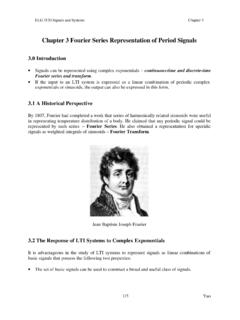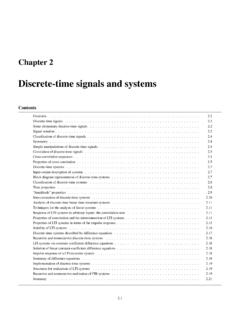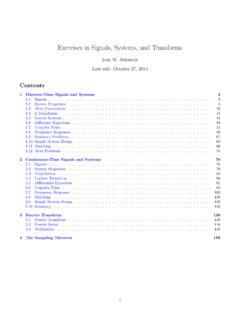Transcription of Notes for Signals and Systems - Johns Hopkins University
1 Notes for Signals and Systems Version Wilson J. Rugh These Notes were developed for use in , Signals and Systems , Department of Electrical and Computer Engineering, Johns Hopkins University , over the period 2000 2005. As indicated by the Table of Contents, the Notes cover traditional, introductory concepts in the time domain and frequency domain analysis of Signals and Systems . Not as complete or polished as a book, though perhaps subject to further development, these Notes are offered on an as is or use at your own risk basis. Prerequisites for the material are the arithmetic of complex numbers, differential and integral calculus, and a course in electrical circuits.
2 (Circuits are used as examples in the material, and the last section treats circuits by Laplace transform.) Concurrent study of multivariable calculus is helpful, for on occasion a double integral or partial derivative appears. A course in differential equations is not required, though some very simple differential equations appear in the material. The material includes links to demonstrations of various concepts. These and other demonstrations can be found at ~ Signals / . Email comments to are welcome. Copyright 2000 -2005, Johns Hopkins University and Wilson J. Rugh, all rights reserved. Use of this material is permitted for personal or non-profit educational purposes only.
3 Use of this material for business or commercial purposes is prohibited. 2 Notes for Signals and Systems Table of Contents 0. Introduction ..4 Introductory Comments Background in Complex Arithmetic Analysis Background Exercises 1. Signals ..10 Mathematical Definitions of Signals Elementary Operations on Signals Elementary Operations on the Independent Variable Energy and Power Classifications Symmetry-Based Classifications of Signals Additional Classifications of Signals Discrete-Time Signals : Definitions, Classifications, and Operations Exercises 2.
4 Continuous-Time signal Classes ..23 Continuous-Time Exponential Signals Continuous-Time Singularity Signals Generalized Calculus Exercises 3. Discrete-Time signal Classes ..37 Discrete-Time Exponential Signals Discrete-Time Singularity Signals Exercises 4. Systems ..43 Introduction to Systems system Properties Interconnections of Systems Exercises 5. Discrete-Time LTI Systems ..50 DT LTI Systems and Convolution Properties of Convolution - Interconnections of DT LTI Systems DT LTI system Properties Response to Singularity Signals Response to Exponentials (Eigenfunction Properties) DT LTI Systems Described by Linear Difference Equations Exercises 6.
5 Continuous-Time LTI Systems ..68 CT LTI Systems and Convolution Properties of Convolution - Interconnections of DT LTI Systems CT LTI system Properties Response to Singularity Signals Response to Exponentials (Eigenfunction Properties) CT LTI Systems Described by Linear Difference Equations Exercises 7. Introduction to signal Representation ..82 Introduction to CT signal Representation Orthogonality and Minimum ISE Representation Complex Basis Signals DT signal Representation Exercises 8. Periodic CT signal Representation (Fourier Series).
6 92 CT Fourier Series Real Forms, Spectra, and Convergence Operations on Signals CT LTI Frequency Response and Filtering Exercises 9. Periodic DT signal Representation (Fourier Series) ..106 DT Fourier Series Real Forms, Spectra, and Convergence Operations on Signals DT LTI Frequency Response and Filtering Exercises 10. Fourier Transform Representation for CT Signals ..118 Introduction to CT Fourier Transform Fourier Transform for Periodic Signals Properties of Fourier Transform Convolution Property and LTI Frequency Response Additional Fourier Transform Properties Inverse Fourier Transform Fourier Transform and LTI Systems Described by Differential Equations Fourier Transform and Interconnections of LTI Systems Exercises 11.
7 Unilateral Laplace Transform ..143 Introduction Properties of the Laplace Transform Inverse Transform Systems Described by Differential Equations Introduction to Laplace Transform Analysis of Systems Exercises 12. Application to Circuits ..156 Circuits with Zero Initial Conditions Circuits with Nonzero Initial Conditions Exercises 4 Notes for Signals and Systems Introductory Comments What is Signals and Systems ? Easy, but perhaps unhelpful answers, include the and the , the question and the answer, the fever and the cure, calculus and complex arithmetic for fun and profit, More seriously, Signals are functions of time (continuous-time Signals ) or sequences in time (discrete-time Signals ) that presumably represent quantities of interest.
8 Systems are operators that accept a given signal (the input signal ) and produce a new signal (the output signal ). Of course, this is an abstraction of the processing of a signal . From a more general viewpoint, Systems are simply functions that have domain and range that are sets of functions of time (or sequences in time). It is traditional to use a fancier term such as operator or mapping in place of function, to describe such a situation. However we will not be so formal with our viewpoints or terminologies. Simply remember that Signals are abstractions of time-varying quantities of interest, and Systems are abstractions of processes that modify these quantities to produce new time-varying quantities of interest.
9 These Notes are about the mathematical representation of Signals and Systems . The most important representations we introduce involve the frequency domain a different way of looking at Signals and Systems , and a complement to the time-domain viewpoint. Indeed engineers and scientists often think of Signals in terms of frequency content, and Systems in terms of their effect on the frequency content of the input signal . Some of the associated mathematical concepts and manipulations involved are challenging, but the mathematics leads to a new way of looking at the world! Background in Complex Arithmetic We assume easy familiarity with the arithmetic of complex numbers.
10 In particular, the polar form of a complex number c, written as ||jccce = is most convenient for multiplication and division, , 1212()12121 2||||||||jcjcj c cccc ec ec c e + == The rectangular form for c, written ca jb=+ where a and b are real numbers, is most convenient for addition and subtraction, , 121 1 2 2 1212()()cc a jba jb aa jbb+=+ ++ = + + + Of course, connections between the two forms of a complex number c include 221|| ||,() tan (/)cajb abc ajbba =+ = + = + = and, the other way round, 5 Re{} ||cos( ),Im{} ||sin( )acc cbcc c== == Note especially that the quadrant ambiguity of the inverse tangent must be resolved in making these computations.











